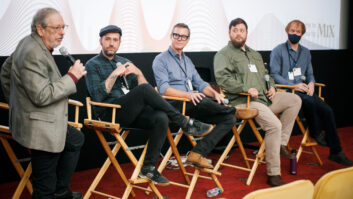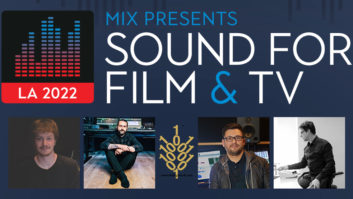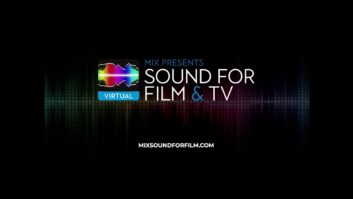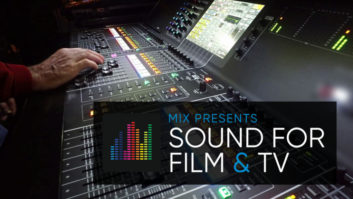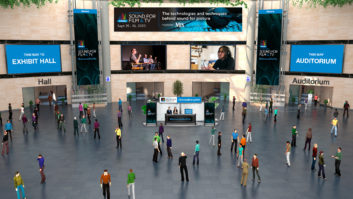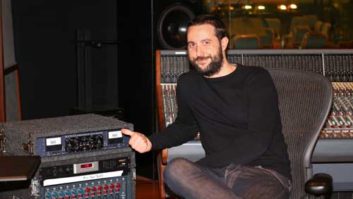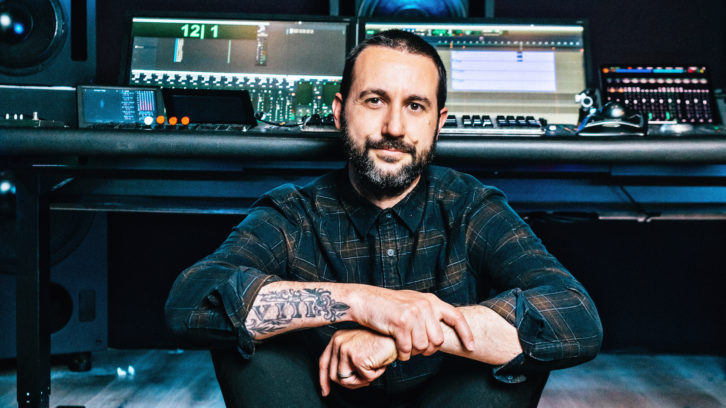
There can’t be enough said about the fine art of ringing out a room. It’s a vital skill for any sound mixer because the key to it is frequency identification—correctly identifying the problematic frequencies that need attenuating. If ever in doubt of its value, consider that it earned scoring mixer/producer and ex-punk guitarist Jason LaRocca the dream job of any rocker—mixing a show at punk haven CBGB in NYC.
“Sometimes on tour, we’d get a really bad front-of-house engineer and I’d help them EQ the monitors,” he explains. “One time, I helped The Adolescents out, EQing their monitors for a soundcheck, and they asked if I wanted to do sound for them at CBGB. It was one of the most exciting moments of my sound career, but I didn’t realize it at the time. I was just partying with my friends and mixing the show. The energy was super-great. It was exactly what you’d envision a CBGB punk show to be.”
Hear Jason LaRocca discuss mixing and more at Mix Sound For Film & TV 2022!
Brothers Joey and Jason LaRocca started a punk band called The Briggs in 2001 with bassist Matthew Stolarz and drummer Chris Arredondo. The cash-strapped musicians found inventive ways to record their early tracks outside the studio, like drilling a hole in the wall between the LaRocca’s childhood bedrooms so they could run an 8-channel XLR snake from Jason’s room, where the drum kit was set up, to the Fostex E-16 tape recorder in Joey’s room.
“We had mics taped to mic stands or just taped to anything we could put a mic on— just like you’d see in photos of the early Dead Kennedys recordings,” LaRocca says. “It was all ad hoc, but that was what we had. We fell into a routine of recording all of our early demos in there that way, and that’s what got us signed, basically.”
Once The Briggs signed to SideOneDummy Records, they had access to real recording studios, such as “The Boat” (owned by the Dust Brothers) in the Silver Lake neighborhood of Los Angeles, and Sage and Sound Recording Studios in Hollywood, yet “we did a lot of overdubs in our home studios or at our friends’ studios,” LaRocca explains. “We did it ourselves. I engineered everything, even in the big studios. I fell in love with that and wanted to keep pursuing it, but we toured a lot so I didn’t have time to get into engineering.”
The Briggs toured with punk icons like Bad Religion, Dropkick Murphys, Anti-Flag and Flogging Molly over the next few years, while LaRocca simultaneously pursued a studio career. As a self-taught engineer, however, landing a studio job proved challenging. “I was calling Sunset Sound and all the local studios in L.A., but without schooling or official training, no one would take me,” he says. Eventually, he got a call from a friend who worked in film composer Mark Isham’s Wet Dog Studios.
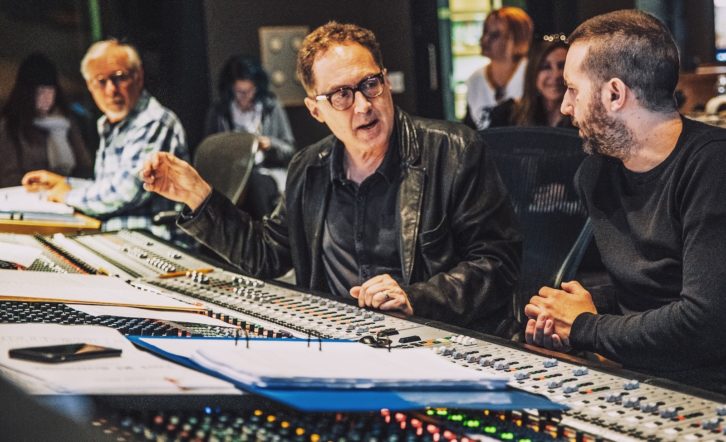
FROM ONE STAGE TO ANOTHER
“My friend was leaving the job, so they were looking for someone to take his place,” LaRocca recalls. “When I went in for the interview, I was at the bottom of the list, and I was really nervous because I had just figured out that Mark Isham composed scores for all my favorite films.” Working with Isham required skills that LaRocca lacked, namely programming analog synthesizers and working with MIDI SysEx. Feeling that the interview didn’t go so well, he asked his friend if he could just show up and help out around the studio.
“I was filing tapes and doing random things around the studio for two-and-a-half weeks, and Mark was interviewing people the whole time,” LaRocca says. “Then one day he said, ‘All right, you should stay. I like you.’ So I interned for nearly two months and learned everything from how to make a good latte for the director, to how to organize all the JVC -inch tape machines, to how to load the S-760 Roland samplers with all the Zip drives. I was ready—more or less—to take over as assistant.
“Mark was scoring Blade, so that was the first film I worked on. We took off from there, and I was just trying to hold on for dear life,” he continues. “I was in the band, doing that as my passion, and now here I am, an assistant in way over his head working for a film composer at the highest level—just being thrown completely into the fire and trying to make a band lift off.” Isham was working with scoring mixer/ engineer Stephen Krause at that time, and LaRocca had assisted Krause with the mix on roughly 10 film scores before getting a chance to mix on his own.
“We were working on Moonlight Mile [2002], and all the tracks were recorded,” he says. “We had spent a couple of days setting up the console and all of Stephen’s great outboard gear. But then he got sick. We didn’t know what to do, but he felt like he could walk me through some of the paths and routing over the phone. So I mixed the film score. I was 21 years old and had only been assisting for three years. We were using the Euphonix CS3000 out to two DA-88s, so we only had 16 tracks to mix to, which was a handful of 5.1 stems. But you couldn’t recall things like you can today in Pro Tools. Once we were done with the mixes and printed for the day, there was no going back. I definitely felt the pressure. It was intense and exciting, and I got the bug for sure.”
In 2004, LaRocca left the studio to tour full-time with The Briggs, but Isham stayed in touch, asking him to mix a couple of film scores when he wasn’t on the road. “My first freelance solo mixing gig was for Mark on Fame (2009), and then we did The Crazies together in 2010. I was touring and then mixing while on break. It was really stressful, and I realized it wasn’t good for me to do both. So I decided to stay home,” he says.
THE STUDIO CALLING
It was a decision that ultimately brought LaRocca great success. In the studio, he worked on music for huge Hollywood films like Morbius, Aquaman, Godzilla: King of Monsters, Bad Boys for Life, The Accountant and The Harder They Fall, and music for AAA game titles and hit television series including The Offer, The Nevers, The Handmaid’s Tale, Black Mirror and A Series of Unfortunate Events. Additionally, he’s worked with recording artists such as Jay-Z, Kid Cudi and CeeLo Green.
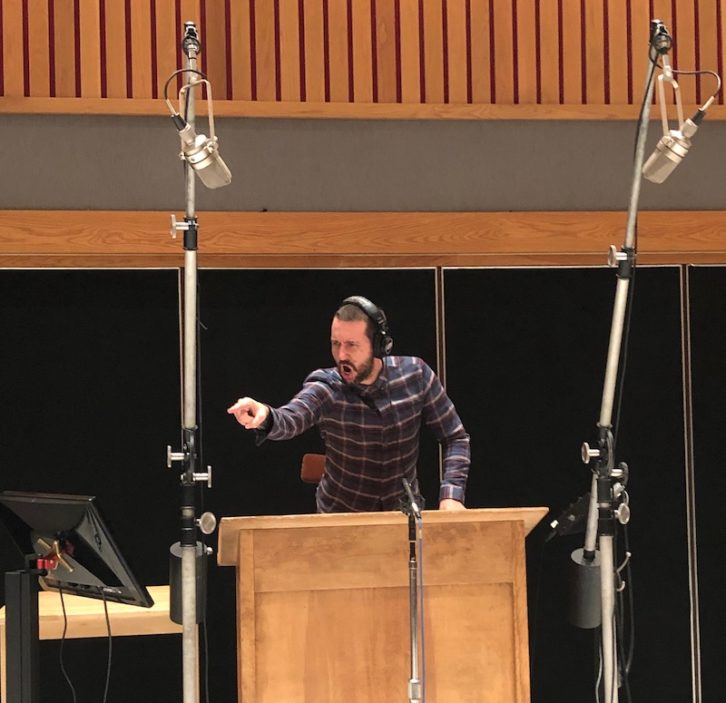
One of LaRocca’s favorite film score experiences was for Paddington (composed by Nick Urata), which he recorded and mixed at AIR Studios in London. “I felt very nervous,” he says. “For me, if you’ve been an engineer on a session at AIR, then you’ve made it. I was there a few days early visiting Lyndhurst Hall, and recording/mix engineer Geoff Foster walked into the room to grab some mics and said, ‘Hi.’ The next day I saw Simon Rhodes, who had just recorded and mixed Alexandre Desplat’s score for The Grand Budapest Hotel at AIR. These guys are the heaviest hitters, and here I am. Nobody knows me, and yet I’m doing this. I was really feeling the pressure, like don’t screw this up. [laughs]. But this place just makes things sound great. As long as you put up some mics that work, the room is going to do all the work for you. It sounded incredible.”
Another career highlight came during the pandemic in the form of Hans Zimmer and his score on Dune. LaRocca, who was tasked with recording the choir for Zimmer’s cover of Pink Floyd’s “Eclipse,” came onto the project in July 2020 just after Los Angeles entered its first round of shutdowns. “We were able to go into the studio, following all the strict protocols. We were only allowed to record four vocalists at a time and yet we had all these intricate parts for them to sing. Layers and layers of ‘oohs and aahs,’ plus there were lead vocalist parts,” he says.
They recorded in Studio B at Zimmer’s Remote Control facilities in Santa Monica. LaRocca recorded separate groups of four vocalists—each singer had his or her own mic and they were physically separated by gobo walls.
In the control room, LaRocca mixed down the first four vocalists and panned them mostly to the left. Then on the second pass, he panned the vocalists a little more to the right and tweaked the balances between the mics from the previous pass. He continued this process for two full days, and as the parts were stacked up and built, they started to interlock. Soon after, it sounded like a full chorus.
“At the end, with all the bounced-down live stereo mixes, we were at the maximum number of voices in Pro Tools that we could run,” he explains. “No one had recorded in person yet after the pandemic hit—let alone recorded a choir—so it was a new challenge for everyone. We didn’t have a choice. I’ve never recorded four vocalists at a time with the hope that it sounds like a hundred, but it worked!”
LaRocca opened his own studio, La-Rocc-AFella Center, in October 2017. The 7.1 surround recording and mixing facility is located in North Hollywood in a multi-studio complex known as Fab Factory Studios. His rooms are outfitted with mirrored Pro Tools systems, so a session created in one can be opened in the other with no compatibility issues. Studio A features an Avid S3 console and Dock control, with Meyer Sound Acheron mains, JBL Cinema surrounds and a Meyer X-400 sub.
Studio B has a 24-channel setup using Avid S1 controllers and an iPad screen, with Dynaudio BM15 near-fields, JBL surrounds and a JBL 18-inch sub. He also has a collection of mics including (but not limited to) Neumann U67s, a Neumann U47 FET, Neumann TLM-170s, Neumann KM184s (matched set), a Sennheiser 421, an AKG 414, a Royer 121 ribbon, a FLEA 47 (with EF12 tube), and many more.
His studio also boasts a fine collection of modular synths—a variety of Eurorack modules by Mutable Instruments, Make Noise, WMD, 4ms, TiTop, Q-Bit, Hexinverter, Roland, Rossum Electronics, Vermona, 2hp, and Steady State Fate, as well as analog outboard gear like a Manley Vari-MU tube compressor (custom-made Mastering Edition), an Empirical Labs EL8-X Distressor (with Brit Mode Mod), a BAE 1073 Dual mic pre, a Grace M108 8-Channel mic pre, and three Chandler Limited REDD.47 Abbey Road Tube mic pre units.
But one man can’t man two studios, so assistant score mixer Michael W. (Mick) Roby, has proven indispensable. “He’s incredible,” LaRocca says emphatically. “He has a really great aesthetic for what is good and what is hip. He went to Berklee and has a degree in music. Honestly, he’s much smarter than me. I really can’t live without him.”

MOVIES, GAMES, MUSIC
The first project to pass through the new studio was the score for Epic Games’ Fortnite, which LaRocca mixed for composers Marco Beltrami and Pinar Toprak. That wasn’t his first video game title, however. He had mixed the OST for composer Daniel Licht’s score on Silent Hill: Downpour in 2011. That was followed by Sunset Overdrive in 2014 (LaRocca’s first game score mix for in-game music), and then came Fortnite. In 2020, LaRocca mixed three game scores: Assassin’s Creed Valhalla, Call of Duty: Black Ops Cold War, and Cyberpunk 2077. And he’s mixed scores for two more games in 2022: Guild Wars 2: End of Dragons for composer Maclaine Diemer, and the highly anticipated God of War: Ragnarök for composer Bear McCreary.
“Of everybody that I’ve worked with, Bear really pushes to get the absolute best out of me. I thank him for that,” LaRocca says.
It’s been quite the year for LaRocca, in fact. He’s also recently finished mixing McCreary’s score for Prime Video’s The Lord of the Rings: The Rings of Power (which launched earlier this month) and he’s mixed Lorne Balfe’s score for Paramount’s theatrical release of Dungeons & Dragons: Honor Among Thieves (slated for March 2023).
So what’s next besides appearing at Mix Sound For Film? “I’d really like to record and mix the score on a David Fincher film; I’m a huge fan of David Fincher,” he says. “I also really like composer Michael Giacchino, and would love to be able to work with him. I love working on film music, but I also love working on pop music, too. Chris Lord-Alge is my hero, and my original dream was to be this great mix engineer like him. I mixed a song for Jay-Z and Kid Cudi and also a song for CeeLo for a film. That was fun. I’d like to work on more records and actually get back into some of that, too.”
